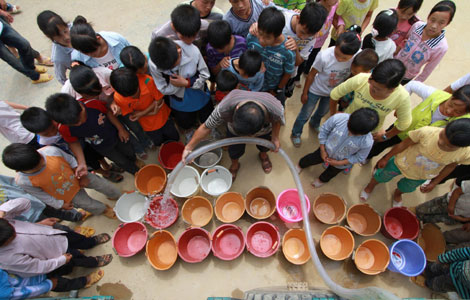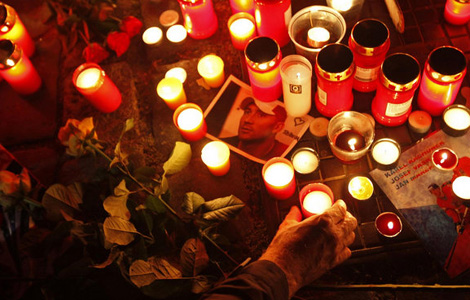Subway crowds get crush warning
Updated: 2011-09-06 07:16
By Xu Wei (China Daily)
|
|||||||||||
BEIJING - In a move that is perhaps stating the obvious, a busy subway station on the Batong Line has put up signs to warn passengers when its platforms are most crowded.
Tongzhoubeiyuan station, a major commuter hub, has posted 10 large blue notices outside entrances that grade passenger flow between 6:30 am and 9:30 am, from average to very crowded.
Staff members said the move is aimed at encouraging people to avoid the station during its busiest period, 7:30 am to 9:30 am.
If successful, the signs will be rolled out at stations along the line, which runs from the eastern suburbs of Tongzhou district to downtown Chaoyang district.
"The notice is mainly aimed at passengers in a hurry who arrive in advance and can use other means of transport," said Gao Chunling, director of Tongzhoubeiyuan station, which limits entry to passengers at peak times.
She added the grading is based on "long time observation and experience".
However, passengers traveling through Tongzhoubeiyuan on Monday seemed less than impressed with the effort.
"No matter how crowded it is, I still have to ride the train to work and try all means to avoid being late," said Deng Wenjun, who rides Batong Line every day. She added that if managers want to alleviate congestion they should shorten the intervals between trains.
Batong Line has seen a steady increase in passenger volume since it opened in 2003, mainly because of the relatively cheap real estate prices along the line, said Gao. It is now one of Beijing's most crowded subway lines, while Tongzhoubeiyuan is among its busiest stations.
"Commuters make roughly 300,000 journeys on the line every day," said Liu Xiaoming, director of Beijing Municipal Commission of Transport during an interview with Beijing Public Service Radio.
Gao said crowding at the station has been greatly alleviated in recent months with the opening of several new bus transit lines.
"We used to receive 1,900 to 2,000 passengers during morning rush hour. Now the figure is only 800 to 1,000," she said.
Cao Yin contributed to this story.
China Daily
(China Daily 09/06/2011 page5)
Hot Topics
Libya conflict, Gaddafi, Oil spill, Palace Museum scandal, Inflation, Japan's new PM, Trapped miners, Mooncake tax, Weekly photos, Hurricane Irene
Editor's Picks

|

|

|

|

|

|







